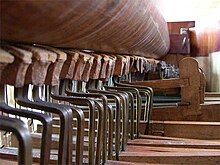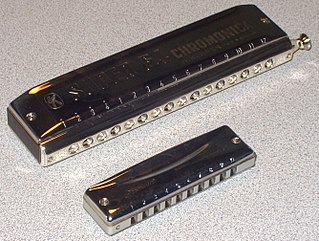
The harmonica, also known as a French harp or mouth organ, is a free reed wind instrument used worldwide in many musical genres, notably in blues, American folk music, classical music, jazz, country, and rock. The many types of harmonica include diatonic, chromatic, tremolo, octave, orchestral, and bass versions. A harmonica is played by using the mouth to direct air into or out of one holes along a mouthpiece. Behind each hole is a chamber containing at least one reed. The most common is the diatonic Richter-tuned with ten air passages and twenty reeds, often called the blues harp. A harmonica reed is a flat, elongated spring typically made of brass, stainless steel, or bronze, which is secured at one end over a slot that serves as an airway. When the free end is made to vibrate by the player's air, it alternately blocks and unblocks the airway to produce sound.

Woodwind instruments are a family of musical instruments within the greater category of wind instruments.
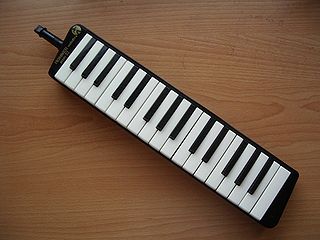
The melodica is a handheld free-reed instrument similar to a pump organ or harmonica. It features a musical keyboard on top, and is played by blowing air through a mouthpiece that fits into a hole in the side of the instrument. The keyboard usually covers two or three octaves. Melodicas are small, lightweight, and portable, and many are designed for children to play. They are popular in music education programs, especially in Asia. The modern form of the instrument was invented by Hohner in the late 1950s, though similar instruments have been known in Italy since the 19th century.

A reed is a thin strip of material that vibrates to produce a sound on a musical instrument. Most woodwind instrument reeds are made from Arundo donax or synthetic material. Tuned reeds are made of metal or synthetics. Musical instruments are classified according to the type and number of reeds.
Hornbostel–Sachs or Sachs–Hornbostel is a system of musical instrument classification devised by Erich Moritz von Hornbostel and Curt Sachs, and first published in the Zeitschrift für Ethnologie in 1914. An English translation was published in the Galpin Society Journal in 1961. It is the most widely used system for classifying musical instruments by ethnomusicologists and organologists. The system was updated in 2011 as part of the work of the Musical Instrument Museums Online (MIMO) Project.

An aerophone is a musical instrument that produces sound primarily by causing a body of air to vibrate, without the use of strings or membranes, and without the vibration of the instrument itself adding considerably to the sound.

An idiophone is any musical instrument that creates sound primarily by the vibration of the instrument itself, without the use of air flow, strings (chordophones), membranes (membranophones) or electricity (electrophones). It is the first of the four main divisions in the original Hornbostel–Sachs system of musical instrument classification. The early classification of Victor-Charles Mahillon called this group of instruments autophones. The most common are struck idiophones, or concussion idiophones, which are made to vibrate by being struck, either directly with a stick or hand or indirectly, with scraping or shaking motions. Various types of bells fall into both categories. A common plucked idiophone is the Jew's harp.
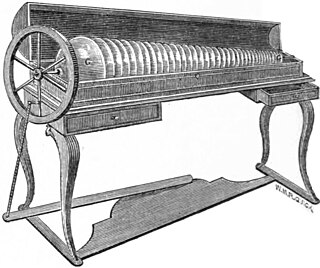
The glass harmonica, also known as the glass armonica, glass harmonium, bowl organ, hydrocrystalophone, or simply the armonica or harmonica, is a type of musical instrument that uses a series of glass bowls or goblets graduated in size to produce musical tones by means of friction. It was invented in 1761 by Benjamin Franklin.
Overblowing is the manipulation of supplied air through a wind instrument that causes the sounded pitch to jump to a higher one without a fingering change or the operation of a slide. Overblowing may involve a change in the air pressure, in the point at which the air is directed, or in the resonance characteristics of the chamber formed by the mouth and throat of the player.
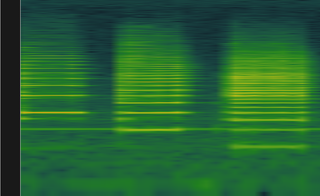
Pedal tones are special low notes in the harmonic series of brass instruments. A pedal tone has the pitch of its harmonic series' fundamental tone. Its name comes from the foot pedal keyboard pedals of a pipe organ, which are used to play 16' and 32' sub-bass notes by pressing the pedals with the player's feet. Brasses with a bell do not naturally vibrate at this frequency.
There are numerous techniques available for playing the harmonica, including bending, overbending, and tongue blocking.

An organ pipe is a sound-producing element of the pipe organ that resonates at a specific pitch when pressurized air is driven through it. Each pipe is tuned to a note of the musical scale. A set of organ pipes of similar timbre comprising the complete scale is known as a rank; one or more ranks constitutes a stop.
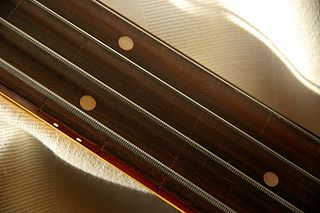
In music, strings are long flexible structures on string instruments that produce sound through vibration. Strings are held under tension so that they can vibrate freely, but with control. This is to make the string vibrate at the desired pitch, with looser strings producing lower pitches, and tighter strings producing higher pitches. However, a vibrating string produces very little sound in of itself. Therefore, most string instruments have a sounding board to amplify the sound.
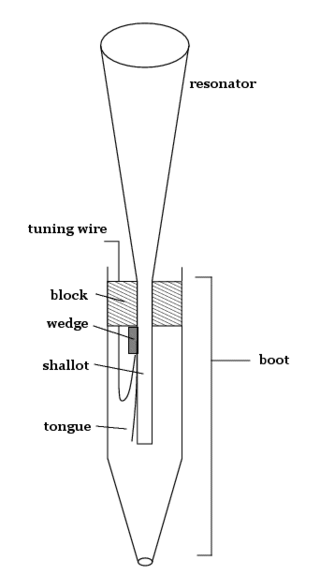
A reed pipe is an organ pipe that is sounded by a vibrating brass strip known as a reed. Air under pressure is directed towards the reed, which vibrates at a specific pitch. This is in contrast to flue pipes, which contain no moving parts and produce sound solely through the vibration of air molecules. Reed pipes are common components of pipe organs.

The Subharchord is a synthesizer featuring subharmonic synthesis. It was developed in the mid-20th century by technicians in the German Democratic Republic.
Georg Anton Reinlein was a musical clock maker in Vienna. A patent was granted to him in the year of 1824 for improving of the Hand harmonica (Physharmonica). The Instrument had free reeds of Chinese manner and bellows that were hand operated.
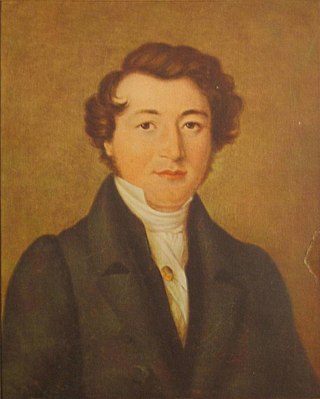
Christian Friedrich Ludwig Buschmann was a German musical instrument maker and inventor, often credited with inventing the harmonica and also the accordion.
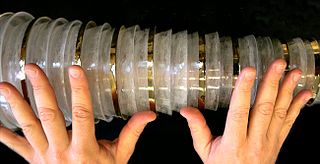
Friction idiophones is designation 13 in the Hornbostel-Sachs system of musical instrument classification. These idiophones produce sound by being rubbed either against each other or by means of a non-sounding object. Instruments of this type are not very common; possibly the best known examples are the musical saw and the nail violin.
This family of musical instruments includes those whose primary material is glass. They may be played using percussive techniques, such as striking the glass to produce a sound, or by utilizing friction to generate a resonant sound. Many glass instruments produce an ethereal, otherworldly timbre. A well-known glass instrument is Ben Franklin's glass harmonica.

